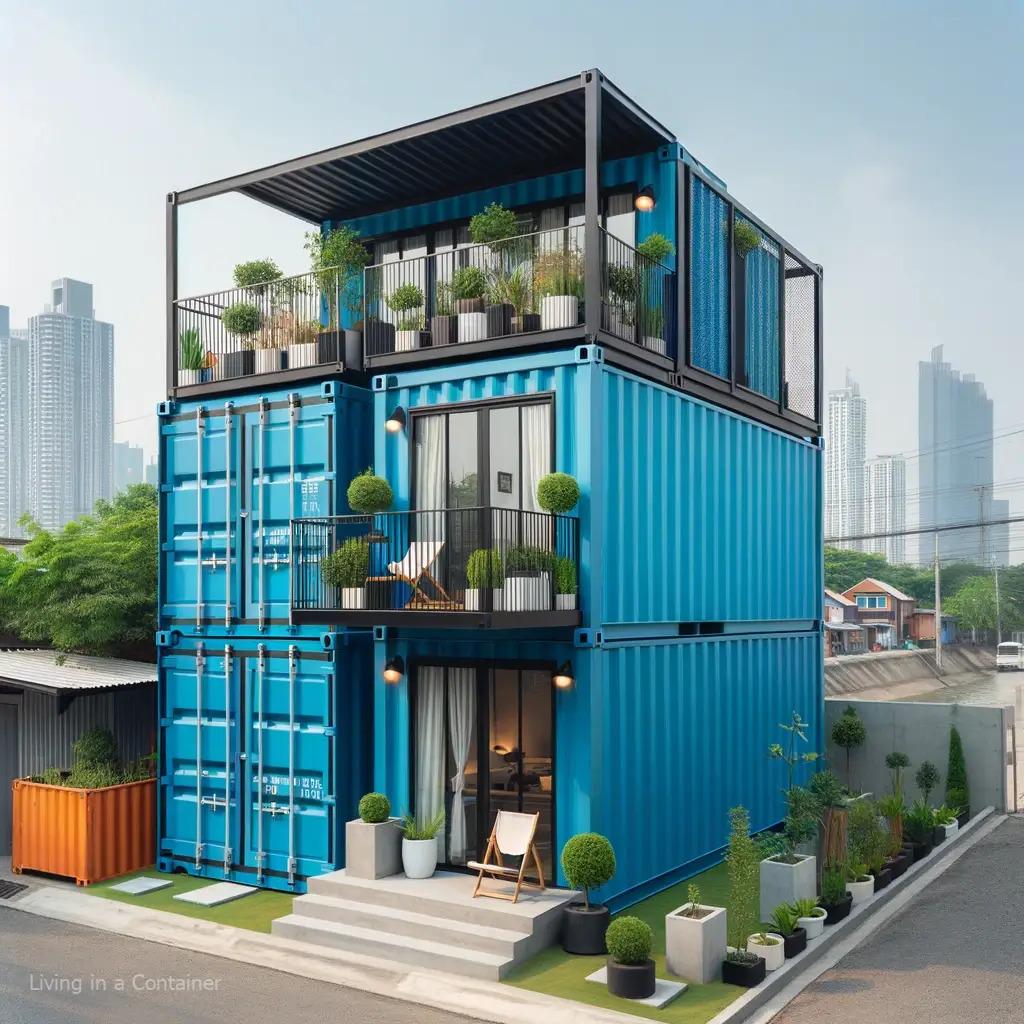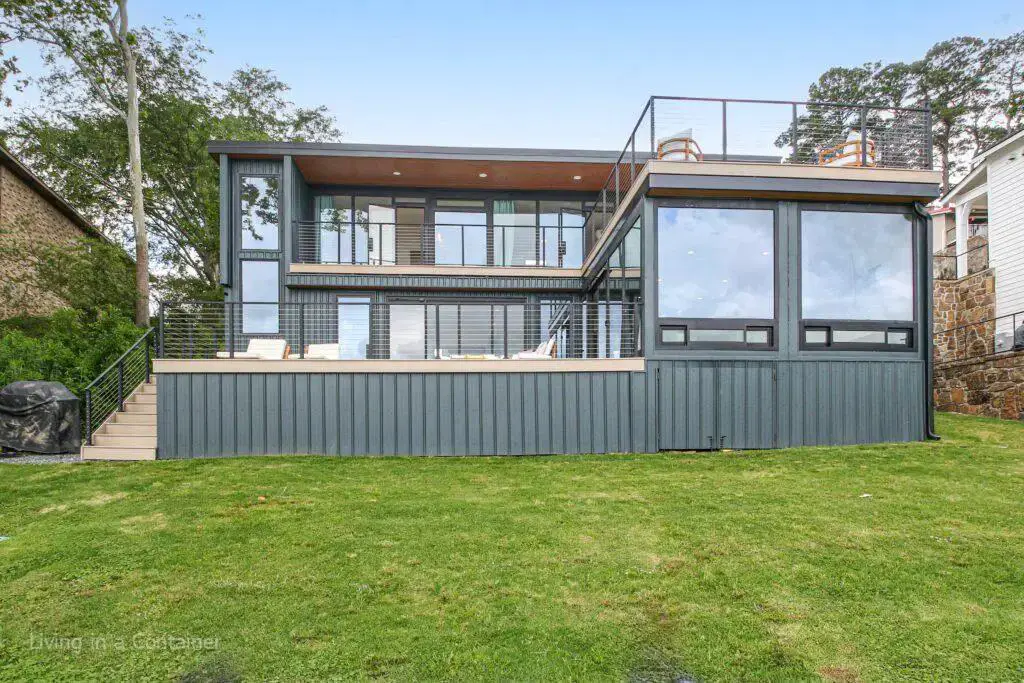In a world where innovation meets sustainability, the concept of shipping container homes has emerged as a game-changer.
This revolutionary approach to home building brings together design savvy hobbyists and eco-focused homeowners, all seeking material that is as versatile as their imagination.
Construction containers aren’t just components of global commerce anymore; they’re being repurposed into multi-dimensional living spaces that are as eco-friendly as they are aesthetically pleasing.
Whether you’re an aspiring architect or a nature-loving homeowner, creating your own container home can be a challenging yet rewarding endeavor.
The incredible versatility of shipping containers as homes.
Find yourself gazing at a steel box, contemplating its potential? Let your mind marvel at the possibilities. Steel containers, unassuming and cold at first glance, are the backbones of some of the most innovative and comfortable living spaces you’ll see all over the globe.
First things first, understand that these containers are built to last. Constructed to withstand harsh climates at sea, they’re sturdy, durable and can resist a lot of weather battering. That’s a significant plus point. No more worrying about tornadoes or storms!
But how can one transform this rigid structure into a homey abode? Here’s a glimpse of the magic.
Step one? Planning the layout. This requires mapping where the entrance, windows, and interior partitions will be. Design it to optimize sunlight and cross-ventilation – do this right, and you save energy as well. Consider putting in insulation at this stage. This will help keep your container home both warm and cool when needed.
Next, cut and modify the container based on your plan. This process might involve removing sections for windows and doors, as well as adding interior walls. But remember, hire a professional or someone proficient with power tools to avoid damaging the structural integrity of the container.
Then, it’s time to add utilities. Install water, sewage, and electrical systems. Pay close attention to integrating these into the design without compromising aesthetics. Use the vertical space smartly to minimize the area they take and return functionality to the container home.

Once your utilities are in place, it’s time for insulation. Think about what type works best for your climate. Blanket insulation, foam insulation, and panel insulation all have different characteristics that suit different needs. Insulation is an essential step to ensure comfort inside the container home, preventing unnecessary heat loss or gain.
Fitting out the interior comes next. Install walls, floors, a ceiling, and fixtures. Think about where you padded the container for insulation and where you didn’t — this may dictate where some fixtures can go.
Windows and doors come in next. They need to fit in nicely with the chosen design. It’s usually best to use custom-made fixtures to ensure the best fit. This also offers a chance for personalization, turning the container into a reflection of you.
Finally, fun park; painting! Choose paints specifically designed for metal surfaces. To avoid rust, priming the surface before painting is a crucial step. Don’t shy away from bright colors and bold designs. They render your container home unique and vibrant.
And standing before you, a once simple steel box has turned into a comfortable, enviable home, proof that with a bit of skill, patience, and creativity, making a home can be as much a pleasure as living in it. This humble yet resilient steel box, leftover from global commerce, gets a chance to host life, bear witness to love, laughter, and the beautiful everydayness that makes ‘home.’
Turning a lifeless steel box into a lively home is not only a leap towards sustainable living but also a testament to human ingenuity and creativity. It’s more than just a lifestyle; it’s a silent revolution. The next time you see a steel box, remember it’s a hidden gem waiting for its transformation.

The environmental impact of shipping container homes.
Reusing What’s Already There
Easily among the most striking advantages of shipping container homes is their repurposing of existing materials. Rather than procuring fresh resources, these homes utilize shipping containers that are already afloat in the marketplace. These containers, usually built to weather the rigorous demands of transoceanic shipping, would otherwise go unused or worse, end up in a landfill. Container homes therefore help reduce waste and decrease demand for new construction materials.
Low Energy Consumption During Construction
Compared with conventional housing, shipping container homes require significantly less energy for construction. Traditional residential projects involve machinery and equipment like cranes, bulldozers, and trucks to excavate and prepare the land before building can even start. But shipping container homes eliminate the need for many of these initial steps, resulting in fewer carbon emissions.
Reduced Building Material Waste
The precision required for modifying a shipping container into a livable space demands careful planning and execution. As a result, there’s a drastic decrease in the amount of building material waste produced. Every piece of wood, panel of insulation, and length of piping has its place. What’s more, the remnants from creating doors or windows can often be reused elsewhere in the project, further reducing waste.
Efficient Use of Space
Container homes inherently promote the efficient use of space. The finite dimensions of a shipping container encourage a minimalist, “only what’s necessary” approach to layout and design. This translates to lower resource usage over time as occupants are inclined to own less stuff and therefore generate less waste.
Potential for Off-Grid Living
The characteristics of shipping container homes — reduced size, built-in structure, strength, and mobility — make them attractive for those who wish to live off-grid. When coupled with sustainable technologies like solar panels, composting toilets, and rainwater harvesting systems, these dwellings can enable truly self-sufficient living with minimal environmental footprint.
Choice of Non-VOC Products
Finally, thank you to the incredible growth of green building technology, shipping containers can be converted into homes using a plethora of non-toxic, non-VOC products, from adhesives and sealants to finishes. Using such products helps maintain indoor air quality while also decreasing the home’s overall environmental impact.
In summary, whether through recycling materials, reducing energy and waste, encouraging conscious living, or incorporating green technologies, the shipping container home emerges as a truly eco-friendly housing choice, one that embodies the best of environmentally responsible architecture.

The challenge and satisfaction of creating your own shipping container home.
Shipping container homes, once considered a novelty, have emerged as a fascinating alternative for those seeking an authentic off-the-beaten-track home-building experience. But it’s more than just about having a unique dwelling place. There are several challenges and rewards for those brave and creative enough to swing the construction hammer themselves.
Getting your hands on the building blocks for your dream home – the shipping containers themselves – can be an interesting challenge. You may need to look outside the usual channels and scour far and wide until the right containers become available. There’s an element of adventure in there, hunting down that perfect box in the right condition at an affordable cost.
Remember that not every shipping container is likely to be suitable for all types of designs. So, the design creativity that a container home permits comes attached with its fair share of constraints. The limited width of standard containers or the difficulty in creating wide open spaces can spur practical design solutions and innovations.
Securing permits and ensuring that the shipping container home adheres to building codes is another exciting challenge. Since they’re still a relatively new concept, many municipalities may not have the specific rules and regulations covering this type of construction in their books. Having a successful dialogue with local officials can feel rewarding when you help pave the way for more sustainable housing in the community.
The ultimate reward, of course, is the satisfaction of living in a home built and designed by your own hands. Each nook, each corner, each aspect of your container home is a testament to your imagination and persevering spirit.
Further rewards lie in the eco-consciousness of a container home. Recycling a shipping container has a much lower ecological impact than traditional construction materials. Plus, it aligns with the principles of minimalist living – a philosophy that cherishes experiences over possessions – helping reduce one’s carbon footprint.
The opportunities for customisation and personalisation are virtually endless. From rooftop gardens to skylight installations, murals to innovative storage solutions – one can play their own home-designing maestro. After all, it’s your canvas, and the world is more than ready to admire the masterpiece that you create.
Last, but certainly not least, is the thrill of potential off-grid living. If you’re installing solar panels or rainwater harvesting systems, the potential for self-sustained living adds an extra layer of both challenge and satisfaction.
Taking the plunge to build your own shipping container home is certainly not for the faint-hearted. But for those willing to take on the challenges, the rewards – a custom-built, eco-conscious, potentially self-sustainable home filled with personal touches and a whole lot of character – are endlessly gratifying. There’s just something special about living in a space that truly embodies your personal story and commitment to a sustainable future.

Building a shipping container home is undoubtedly a demanding project, but the reward of stepping into a dwelling you crafted with your own hands, designed according to personal taste and aspirations, outweighs any challenge.
Shipping container homes not only promote healthy living and sustainable housing methods but also serve as an example of how innovation and recycling can work in tandem.
The success stories of these homes, scattered across the globe, are keeping hobbyists engaged and continuously pushing the boundaries of what’s possible in sustainable housing.
So here’s to creating homes that are not just a source of shelter but also a beacon of sustainability and creative freedom.
